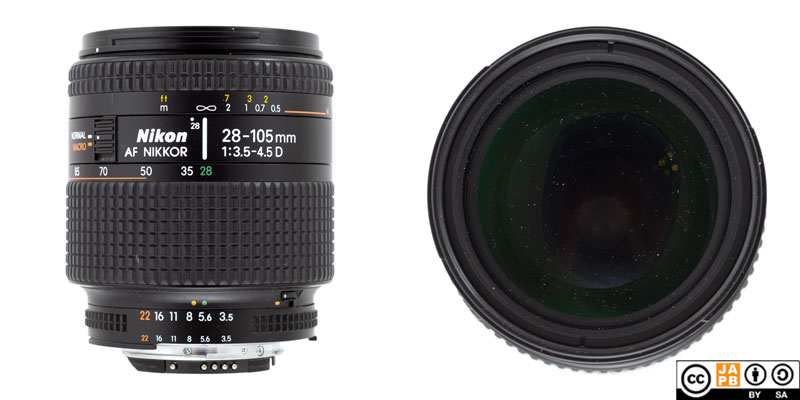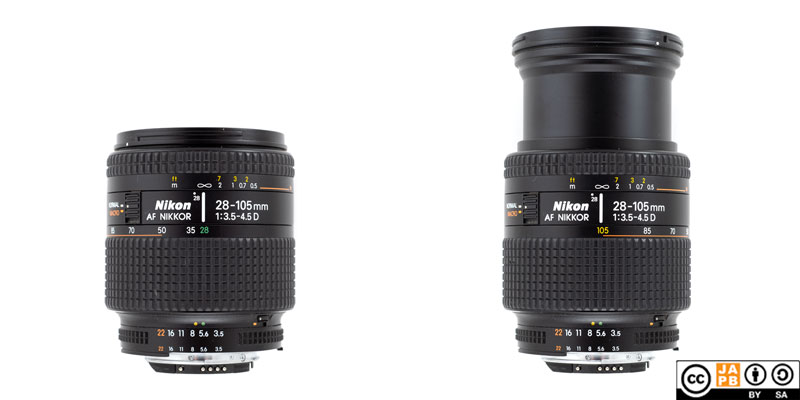Pekka Buttler, 02/2024

Specifications
While the table below summarizes the lens’ key specifications of the pictured sample, the earlier lens differs only minutely
| Brand: | AF Nikkor | Lens name | 28-105mm 1:3.5–4.5 D |
| Focal length(s)1 | 28–105 mm | Angle-of-view2 | 74°–23°20 |
| Maximum Aperture | f/3.5–4.5 | In Production | 1998–2005 |
| Lens mount | Nikon F | Subfamily (if applicable) | AF-D |
| Length3 | 81,6 mm | Diameter4 | 72,4 mm |
| Filter ring diameter | 62 mm | Weight | 450 grams |
| Lens element count | 16 | Lens group count | 12 |
| Aperture blades (S/R/C)5 | 9 R | Focus throw | 30 ° |
| Minimum focusing distance | 50 / 21 cms | Maximum magnification | 1:5,2 / 1:2 |
| Has manual aperture ring | YES | Has Manual focus ring | YES |
| Aperture mechanism type | Automatic | Aperture click stops 6 | 3.5-5.6-8-11-16-22 |
Historical notes
• The Nikkor AF-D 28-105mm f/3.5–4.5 IF was introduced in 1998 to replace the aging Nikkor AF 28–85/3.5–4.5 [data sheet].
• When it was discontinued in 2005 it was not directly replaced by any one lens. Instead, the lack of an internal focusing motor and the not-so-wide wide end of the zoom (at 28 mm) incrementally made the lens look less and less attractive to new users and Nikon seems to have considered its lineup sufficiently comprehensive.
Further notes
• This is one of the few consumer/prosumer Nikkor lenses to feature internal focusing (meaning that focusing is achieved by shifting a subassembly of lens elements within the lens).
• A further upside of being internal focusing is that the lens does not change shape/size when focusing (and that the filter ring/bayonet mount do not rotate during focusing).
• The lens is at its shortest at the 28 mm focal length and at its longest at the 105 mm focal length. In zooming closer, the lens lengthens quite a bit (from 81,6 to 119,7 mm). Moreover, when zooming, the filter ring/bayonet mount rotates (undoing some of the benefit of the filter ring not rotating on focusing).
• With a 30 ° focus throw, this lens is very clearly targeted at autofocus use and precise manual focus is pretty much impossible.
• This lens has a manual aperture ring. Also it is of the generation of Nikon AF lenses where autofocus was still facilitated by a focusing motor in the camera body (not the lens). The lens does not offer controls to switch between manual and auto focus. Instead, this operation would be done on the camera body.
• Nikon offered a dedicated, bayonet-mounted hood for the lens (the HB-18).
• Out-of-the-box the lens offers a more than decent close focusing capability of 0,5 m, allowing a maximum magnification ratio of 1:5,2. However, when the user activates the lens’ ‘macro mode’ (available at focal lengths 50–105mm), the lens’ close focusing capability improves to 21 cm, which results in an impressive 1:2 maximum magnification.
• The lens features a small switch to change between “normal” and “macro” modes. To activate the macro mode, the lens must be zoomed to between 50 and 105 mm; Activating the macro mode unlocks a limiter on the focus ring’s range of motion (giving a focus throw of roughly 55 °); one can set the switch back to “normal” only when the focus is set to the normal range (infinity–0,5 m); as long as that switch is set to “macro” the lens effectively becomes a 50–105 mm zoom (zooming wider than 50 mm is impossible. While this sounds cumbersome, it is both logical and intuitive.
• Being an internal focusing lens, the lens ‘suffers’ significant focus breathing. For instance, when the lens is zoomed to 105 mm and focused to 21 cm, the effective angle-of-view is roughly equivalent to a 50 mm lens.

Right: Nikkor AF 28–105mm f/3.5–4.5 Zoomed to 105 mm
Versions
The Nikkor AF-D 28–105 f/3.5–4.5 IF is Nikon’s only ever zoom lens ranging from 28 mm to 105 mm. During the lens’ 7-year production run only one version was ever manufactured. Roughly 400 000 copies were made.
A brief genealogy of Nikon SLR lens types
Nikon is undoubtedly one of the great names in 35 mm SLR photography. The Nikon F mount has been in continuous production since 1959. During that time, the mount has developed/changed in some detail, however without ever fully sacrificing compatibility.
In short (a longer version is here), the development of Nikon’s SLR lenses can be traced as follows:
• 1959–1977: Pre-Ai. Manual focus lenses that use ‘rabbit ears’ to communicate selected aperture with the camera body.
• 1977–1986: Ai and Ai-s. Manual focus lenses that may have ‘rabbit ears’ for backward compatibility, but are designed to communicate selected aperture with the camera body through indentations in base of aperture control ring.
• 1986–today: AF and AF-D. Autofocus lenses that do not have a focusing motor within the lens, but rely on the focus motor within the camera. All AF and AF-D lenses are simultaneously Ai-s lenses (they are Ai-s lenses extended with AF) 7
• 1996–today AF-S and AF-P. Autofocus lenses that have an internal focusing motor and do not rely on the body having a focusing motor.
Adapting
Besides adapting, this lens can be used natively on all current high-end Nikon dSLRs and several earlier medium-to-high-end older Nikon dSLRs. Moreover, if the camera body contains a slot-drive focusing motor, this lens will even auto-focus8. Likewise, if the lens has been retrofitted with ‘rabbit ears’, it can be natively used on all Nikon F-mount film cameras ever produced (without the rabbit ears, it is limited to post-1977 bodies).
Thanks to being a fully manual lens (manual aperture, manual focus), the lens can be adapted to all mirrorless cameras using a suitable dumb adapter (and such adapters are easy to find). Moreover, a large range of special adapters (helicoid adapters, tilt/shift adapters, speed boosters) for using Nikon F lenses on most mirrorless systems are available. Currently no adapters for mirrorless exist that would allow autofocus through the slot-drive screw.
Using Nikon F lenses on non-Nikon SLRs and dSLRs is likewise a distinct possibility. Thanks to the relatively generous flange focal distance of the Nikon F mount (46,5 mm), adapter rings for all dSLR mounts are available as well as for a goodly portion of film-era SLR mounts. Such rings will not allow autofocus, and are unlikely to support auto aperture, but even then the lenses can be used in stop-down metering mode.
Footnotes
- Focal length is (unless stated otherwise) given in absolute terms, and not in Full-frame equivalent. For an understanding of whether the lens is wide/tele, see ‘Angle-of-view’. ↩︎
- Picture angle is given in degrees and concerns the diagonal picture angle. Rule of thumb:
> 90 ° ==> Ultra-wide-angle
70–90 ° ==> Wide-angle
50–70 ° ==> Moderate wide-angle
40–50 ° ==> ‘Standard’ or ‘normal’ lens
20–40 ° ==> Short tele lens
10-20 ° ==> Tele lens
5-10 ° ==> Long tele lens
< 5 ° ==> Ultra-tele lens ↩︎ - Length is given from the mount flange to the front of lens at infinity. ↩︎
- Diameter excludes protrusions such as rabbit ears or stop-down levers. ↩︎
- S=straight; R=rounded; C=(almost)circular at all apertures. ↩︎
- Numbers equal aperture values on aperture ring; • intermediate click; – no intermediate click. ↩︎
- There is a further sub-class of AF-D lenses called AF-I lenses that are otherwise AF-D lenses (meaning, fully Ai-s compatible), but have an internal focus motor. Only long tele lenses were made in AF-I variants. ↩︎
- As of this writing, the following Nikon dSLRs fully support autofocus, aperture priority and manual metered modes on Nikkor AF/AF-D lenses: D2, D3, D4, D5, D6, Df, D200, D300, D300s, D500, D600, D610, D700, D750, D780, D800, D800E, D810, D850, D7000, D7100, D7200 ↩︎